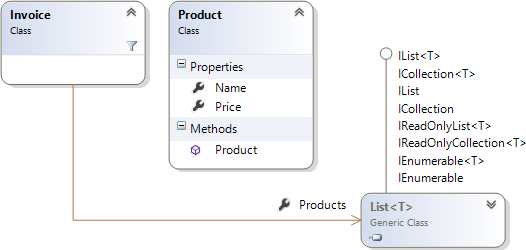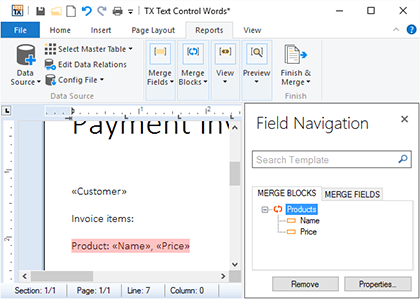TX Text Control .NET for Windows Forms Reporting GuideTechnical Article: Using Objects as Data Sources
The direct use of enumerable business objects as a data source to merge templates is one of the typical scenarios with TX Text Control Reporting.
MailMerge interprets all public properties of objects in the collection as table columns and child tables. Properties of type IEnumerable are automatically instantiated as relations and are used for merge blocks and nested merge blocks.
Consider the following class structure as a data source:

Below is the code that represents the above UML class design:
public class Invoice
{
public List<Product> Products
{
get;
set;
}
public Customer Customer
{
get;
set;
}
}
public class Product
{
public Product(string Name, Decimal Price)
{
this.Name = Name;
this.Price = Price;
}
public string Name
{
get;
set;
}
public Decimal Price
{
get;
set;
}
}Public Class Invoice
Public Property Products() As List(Of Product)
Get
Return m_Products
End Get
Set
m_Products = Value
End Set
End Property
Private m_Products As List(Of Product)
Public Property Customer() As Customer
Get
Return m_Customer
End Get
Set
m_Customer = Value
End Set
End Property
Private m_Customer As Customer
End Class
Public Class Product
Public Sub New(Name As String, Price As [Decimal])
Me.Name = Name
Me.Price = Price
End Sub
Public Property Name() As String
Get
Return m_Name
End Get
Set
m_Name = Value
End Set
End Property
Private m_Name As String
Public Property Price() As [Decimal]
Get
Return m_Price
End Get
Set
m_Price = Value
End Set
End Property
Private m_Price As [Decimal]
End ClassThe template consists of a merge block named Products. The merge fields in the block are named Name and Price.

The following code shows how to create the data source object and how to start the merge process using MergeObjects:
Invoice invoice = new Invoice();
invoice.Products = new List<Product>();
invoice.Products.Add(new Product("Apple", 3.55m));
invoice.Products.Add(new Product("Banana", 2.4m));
invoice.Products.Add(new Product("Pineapple", 2.99m));
var invoices = new List<Invoice>();
invoices.Add(invoice);
mailMerge1.MergeObjects(invoices);Dim invoice As New Invoice()
invoice.Products = New List(Of Product)()
invoice.Products.Add(New Product("Apple", 3.55D))
invoice.Products.Add(New Product("Banana", 2.4D))
invoice.Products.Add(New Product("Pineapple", 2.99D))
Dim invoices = New List(Of Invoice)()
invoices.Add(invoice)
mailMerge1.MergeObjects(invoices)